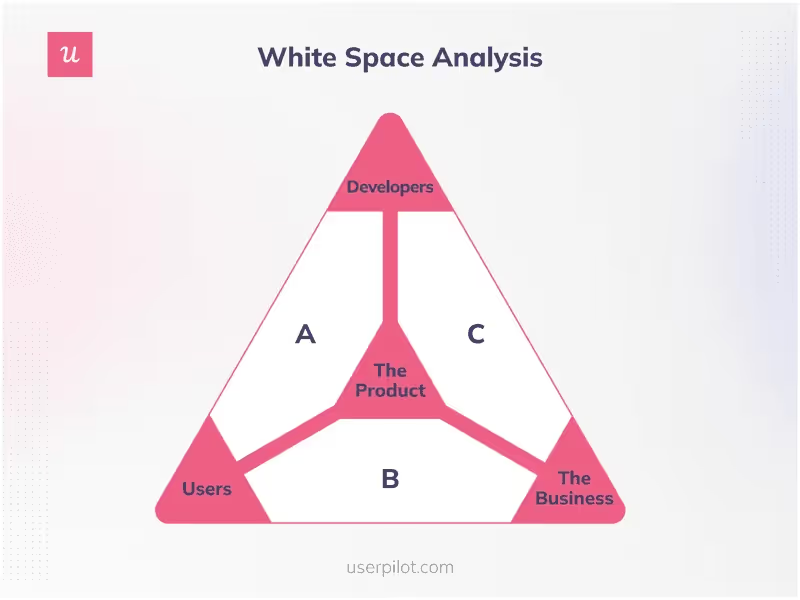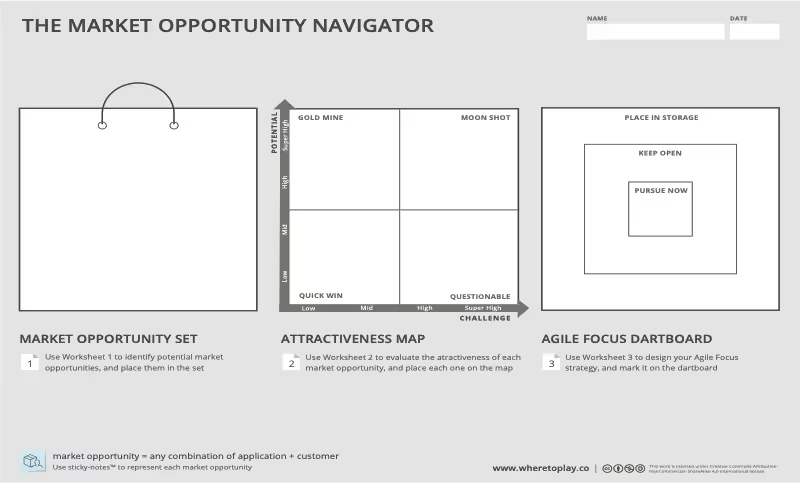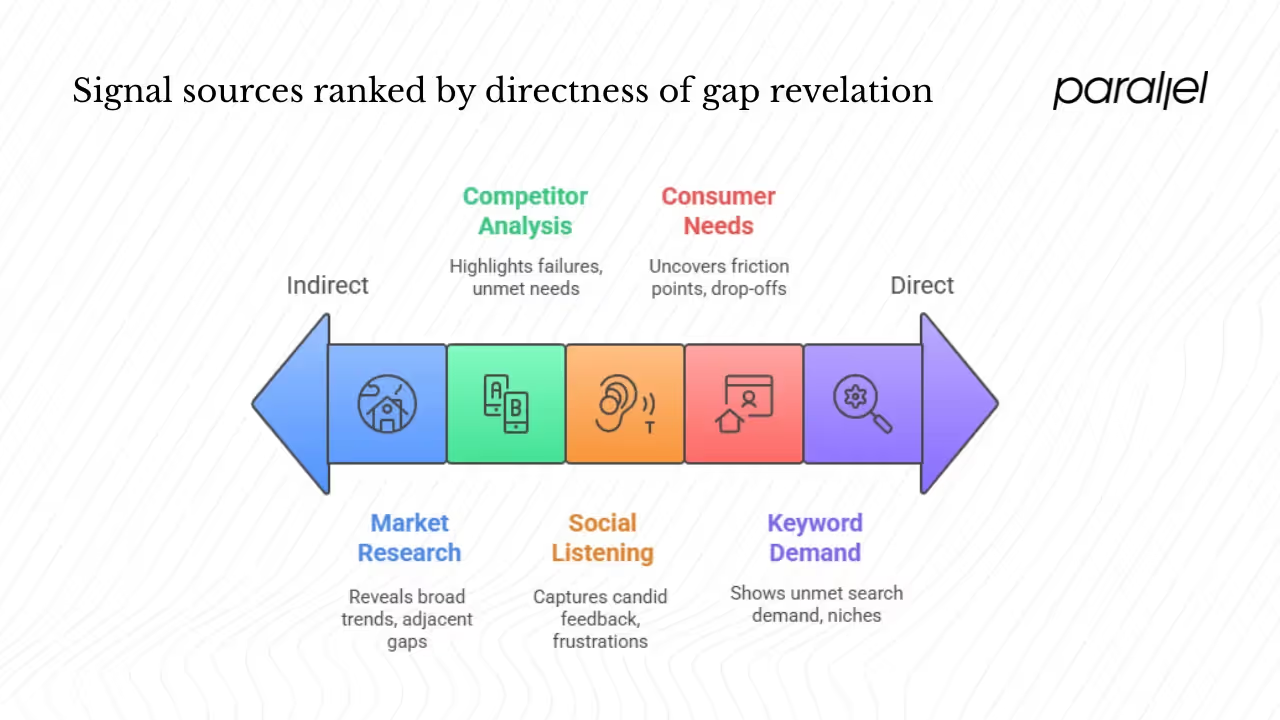How to Find a Gap in the Market: Complete Guide (2026)
Learn strategies to identify market gaps, analyze competition, and discover unmet customer needs to inspire new product ideas.

Early‑stage products live or die on focus. When you launch something that looks like everything else, customers tend to shrug. There’s a reason most “me‑too” products vanish: they copy features without understanding unmet needs. In my experience at Parallel, a much stronger path is to go hunting for gaps.
That means spotting areas where demand exists but supply is weak or flawed, then building a simple product that fixes the issue. It’s what Sam Prince did when he noticed hiring pain points in his restaurant chain and backed a hiring app — “eat your own burrito or solve your own problem,” a colleague said of their approach.
This guide shows founders, product managers and design leaders how to find a gap in the market and use it to build something that matters. Before we get into frameworks and tactics, let’s clarify what a gap is and how you can start discovering one — because understanding how to find a gap in the market is the foundation for everything that follows.
What do we mean by a gap in the market?
A gap in the market is a mismatch between what customers need and what businesses offer. It can take many shapes: a niche segment that no one serves, a missing feature in existing products or a quality standard not met by incumbents. The research platform Appinio describes gap analysis as a method for assessing the difference between the current state of a business and its desired state.
When you apply that mindset to markets, you examine the difference between customer demand and the supply of solutions. This is slightly different from “white space” or “opportunity space,” which often refer to unexplored but speculative ideas. Market gaps are grounded in actual unmet demand. Value gaps, meanwhile, occur when a product promises more than it delivers or when its benefits aren’t clear enough to customers. Understanding these details helps you connect gaps to differentiation, niche selection and unsatisfied demand.

Finding a gap does not mean chasing everything that looks empty. As Attest’s 2024 guide warns, brands that rush into uncharted territory without checking for real demand often launch unnecessary products. A gap must be both real and relevant. Ask why it exists: are incumbents ignoring it because it’s too small or because they can’t see it? Does it fit what you’re good at? If the answers point to a genuine problem that you can solve well, you might be onto something.
When you do find a valid gap, the rewards can be meaningful. Dovetail’s 2024 guide outlines the advantages of filling market gaps: being first can grant brand recognition and market share, tapping into unmet needs opens new revenue streams, meeting previously unaddressed needs improves satisfaction and loyalty, and differentiation sets you apart from larger competitors. It even points out that becoming the go‑to provider for a new need can set you up for long‑term leadership. Those benefits only materialise when the problem is real and your solution is thoughtfully designed.
Reframing your perspective: start with problems, not solutions
The first step in learning how to find a gap in the market is to adjust your lens. Instead of brainstorming feature lists, start by asking what problems exist. Listen to complaints and observe work‑arounds. Pay attention to what people do when existing solutions fall short. User empathy and curiosity aren’t optional — they drive gap discovery. Many gaps remain invisible until you zoom in on specific contexts or user stories. When Sam Prince’s team noticed that recruiting staff for their restaurants was a constant pain, they didn’t create just another job board. They built Zapid Hire, an app that uses short personality‑driven videos for hiring. That success came from solving their own problem, which often reveals gaps others miss.
Adopt a mindset of empathy
Spending time with users – watching them use your product, talking to them about their workarounds and frustrations – reveals details that analytics alone can’t provide. In 2024, Optimal Workshop found that only 16 percent of organizations fully embed user research into their processes, and more than half don’t measure its impact. That gap between stated intent and actual practice means there’s room for differentiation simply by listening better. Make research part of your routine, not a one‑off effort. When you see a user hack together multiple tools or drop off at a certain point, there might be a gap there waiting to be filled.
Problems before solutions
When you look at problems first, you avoid the trap of building a feature because it’s fashionable. The Attest article observes that companies often view untouched spaces as a chance for first‑mover advantage and end up launching products no one needs. Starting with user pain keeps you grounded. Compile a list of recurring frustrations, tasks that take too long or desired outcomes that existing tools fail to deliver. Prioritize those that match your expertise and resources.
Core frameworks for gap hunting
Frameworks provide structure when you’re learning how to find a gap in the market. Below are three that I use regularly with clients.
Gap analysis and gap maps
Gap analysis compares the current state of a business or product to a desired future state and highlights the difference. Dovetail calls it a way to compare actual performance with envisioned performance and replicate successes while avoiding mistakes. The steps are simple: choose an area of focus, set goals, measure the current state, define the desired state and then see where the gaps lie. In product work, a gap map visualizes these differences. You plot user needs on one axis and the degree of satisfaction or availability on the other. Clusters of low satisfaction reveal underserved needs.

White‑space analysis
White‑space analysis looks at where current offerings stop. Appinio explains that market gap analysis centres on understanding the difference between demand for a product or service and what your business currently offers. To perform white‑space analysis, list existing solutions and their focus areas, then identify adjacent or unserved segments. Be cautious: white space might represent a future opportunity or a dead zone. Combine quantitative demand signals (search volume, purchase data) with qualitative research to decide whether it’s worth entering.

Market Opportunity Navigator
Developed by Marc Gruber and Sharon Tal, the Market Opportunity Navigator (MON) is a three‑step method for identifying and prioritizing opportunities. According to the MON overview, the steps are: generate a set of possible markets, evaluate their attractiveness, and design an agile focus strategy. MON encourages you to think in portfolios: don’t bet everything on one gap. Instead, map several adjacent opportunities, assess them on criteria like market size, pain intensity and strategic fit, then pick one to pursue while keeping options for future pivots. This structured approach reduces the chance of chasing shiny objects.

Signal sources: where gaps reveal themselves
Learning how to find a gap in the market isn’t about epiphanies. It’s about gathering signals from many places and spotting patterns. Here are some of the richest sources I’ve used.
1) Market research and trend analysis
Macro trends provide context. Reports, trade journals and analyst forecasts show how technology, consumer behaviour and regulation are shifting. For example, the 2025 Stanford Artificial Intelligence Index reports that 78 percent of organizations used artificial intelligence in 2024, up from 55 percent the year before. Investment in generative artificial intelligence increased to $33.9 billion, and businesses see productivity gains. Such data indicates that artificial intelligence–driven products are moving from novelty to necessity.
When new technologies become widely adopted, adjacent gaps open up — from tools that manage complexity to niche applications and ethical considerations. Innovations often jump domains. Monitoring these shifts helps you see where existing solutions will soon feel outdated.
2) Consumer needs and behavioural patterns
Nothing beats talking to users. Use interviews, ethnographic studies and contextual inquiry to understand behaviours. Pair this with quantitative signals from surveys and analytics. Userpilot’s analytics guide explains that standard web tools show traffic and page views but fail to reveal why users act the way they do.
By recording actions like clicks, scrolls and website submissions, you can uncover friction points and drop‑offs, then improve conversion. The same article describes a case where an e‑commerce platform (CYBERBIZ) used product analytics to track page views and session durations, revealing which features were used most and where users experienced friction. Use this kind of behavioural data to spot unmet needs and feature gaps.
3) Competitor and substitute analysis
Competitor research isn’t just about feature checklists. According to a Nielsen Norman Group article on competitive usability evaluations, benchmarking competitors helps teams avoid implementing useless features and provides objective, risk‑reducing insights. Their research also points out that such evaluations encourage value‑driven improvements and let teams learn from others’ successes and failures. A 2024 Uxtweak report on a Nielsen Norman survey found that 61 percent of UX professionals prioritise competitive analysis to identify differentiation and innovation. In short, studying what competitors do well — and where they fall short — is a powerful way to spot gaps.
Start by mapping direct competitors, indirect competitors and substitutes such as manual processes or spreadsheets. Review their positioning, pricing and support quality, and look at the problems they fail to solve. Read negative reviews on platforms like G2 or Amazon because complaints often point to unmet needs. Study non‑product competitors too — if people are hacking together spreadsheets or combining multiple tools, that’s a sign there’s room for improvement.
4) Keyword and search demand signals
SEO tools reveal what people are searching for but not finding. Long‑tail queries with high search volume but few relevant results can indicate underserved niches. For example, if thousands of people search for “accessible project management for left‑handed designers” and find nothing credible, that’s a potential gap. Use search data as an input, not a verdict. Validate the need with real users before acting.
5) Social listening and community mining
Forums, Reddit threads and Slack or Discord communities are hotbeds of candid feedback. People share frustrations, ask “if only this existed” questions and describe workarounds. Pay attention to recurring complaints and feature requests. Combine this with social listening tools to track mentions and sentiment. Always follow up with direct conversations and surveys. Unstructured comments are starting points, not conclusions.

Structuring, validating and prioritizing gaps
Once you’ve gathered signals and learned how to find a gap in the market, the challenge is to turn them into actionable insight. This section explains how.
1) Niche identification and segmentation
Most markets are too broad to address as a whole. Slice them into segments based on job roles, company size, behaviour or unmet needs. Look for segments with high pain, willingness to pay and low competition. At the same time, avoid segments so narrow that your total addressable market is tiny. A niche should be specific enough to have clear shared needs yet large enough to sustain a business. In one project, a nascent SaaS company building artificial‑intelligence tools aimed to reach “every knowledge worker.” That vague target led to diffused messaging. Narrowing the audience to customer‑support managers with high ticket volumes gave them clarity and traction.
2) Evaluating the gap: size, feasibility and fit
Not every gap is worth chasing. Estimate the market size using total available market (TAM) and serviceable obtainable market (SOM). Consider technical feasibility and whether you can build and maintain a solution. Check business model fit: does the gap fit with how you make money? Evaluate timing — entering too early can leave you burning cash before the market matures, while entering too late means incumbents will dominate. Factor in regulation, supply chain constraints and competition. Running small experiments, like a landing page or concierge MVP, can tell you whether people will pay without sinking months into development.
3) Hypothesis formation and validation
Frame gaps as testable statements. For example: “Design leads at 10‑50 person startups struggle to measure onboarding effectiveness because current analytics tools lack qualitative insight.” Then design experiments: send a survey, build a simple landing page outlining your solution and see if people sign up, or provide a concierge service manually to validate willingness to pay. Define success metrics in advance: number of sign‑ups, willingness to pay, engagement levels. Validate quickly and be ready to discard or refine your hypothesis.
4) Iteration, pivoting and continuous scanning
Gaps shift over time as markets change and competitors appear. Build systems to keep listening: monitor analytics, collect feedback and revisit ideas you parked earlier. Pivot when experiments show that your hypothesis doesn’t hold or when a more promising gap appears. At Parallel, we maintain a “gap backlog” where we log observations, research notes and experiments. This keeps our eyes open without derailing current execution.
Execution and product strategy once you pick a gap
Knowing how to find a gap in the market is only half the battle. You still need to build a solution, position it and grow it.
1) Build a differentiated solution
Design a product that directly addresses the unmet need you’ve identified. Resist the urge to chase feature parity with incumbents. Focus on doing one thing exceptionally well for a specific user group. IDEO points out that growth today comes from creating differentiated solutions tailored to local conditions and contexts. Designers need to understand economic and demographic shifts to decide what to design. In the Zapid Hire example, they didn’t try to replicate mainstream job boards. Instead they focused on video‑based hiring to fix a pain point in restaurant staffing. Define a unique value proposition: what outcome do you deliver, for whom and why is it better? The product should be simple enough for early users to adopt yet extensible enough to grow over time.
2) Messaging, positioning and go‑to‑market
Explain the gap in your story. People need to understand why your product exists. For example, “Existing tools don’t show our candidates’ personality, so we built a video hiring app.” Speak directly to your niche in plain language and avoid jargon. Early adopters often come through targeted outreach: engaging in communities, writing thought pieces that bring attention to the gap and offering personal demos. Landing pages should test messaging, not just collect emails.
3) Monitoring, scaling and gap expansion
Track metrics that indicate whether you’re solving the core problem: adoption rates, retention, task completion times and user satisfaction. Watch for signals that your niche is saturated or new adjacent gaps are opening. As you gain traction, decide whether to expand horizontally (serving adjacent segments) or vertically (adding more functionality for your current segment). Growth should come from solving real problems, not from fear of competition. Stay humble: markets change, and today’s gap can be tomorrow’s commodity.
Case studies and mini examples

Zapid Hire: solving your own problem
When Sam Prince’s restaurant group struggled with hiring, they didn’t settle for traditional job ads. Dewaz, a partner, explained that it’s good to “eat your own burrito or solve your own problem”. By building an app that used short personality‑driven videos for job ads and applications, they addressed a pain point in hospitality recruiting. Within three years, Zapid Hire reached 3,000 businesses and $2 million in recurring revenue. The lesson: start with a specific problem you feel deeply, and other people in similar situations will likely share that need.
Counterexample: chasing a gap that wasn’t there
Not every unserved niche is valuable. One team built a social‑media analytics dashboard for small cafés, only to learn that most café owners used built-in insights or agencies and had no appetite for another tool. They pivoted to a scheduling app that saved time, illustrating the lesson: validate your hypothesis before building.
Walk‑through: spotting and validating a gap
Here’s how you might apply these steps:
- Gather signals: In user interviews, independent consultants complain about sending invoices in multiple currencies. Competitor research shows existing tools support limited currencies or charge high fees. Freelance forums discuss hacks and work‑arounds.
- Define the gap: “Consultants need an easy way to send and receive invoices in different currencies without high fees.”
- Evaluate size and fit: Estimate how many consultants face the issue, how much they bill and whether existing payment platforms can support a solution. Make sure it fits your skills and business model.
- Test and validate: Build a simple landing page outlining the idea. Run a small ad campaign to see if people sign up. Offer a concierge service — manually send invoices and handle currency conversion — to gauge willingness to pay.
- Decide: If enough consultants sign up and provide positive feedback, move forward. If not, refine your hypothesis or explore another gap.
Conclusion
Learning how to find a gap in the market isn’t about grand inspiration. It’s a disciplined practice of looking at problems through the eyes of users, comparing what exists to what’s needed and testing whether your solution holds water. Gaps exist everywhere — in products that overpromise and underdeliver, in niche segments that incumbents ignore and in frustrations that people whisper about in forums. By following a structured process — reframing your perspective, using frameworks like gap analysis and MON, gathering signals, validating hypotheses and iterating — you can build products that stand out because they genuinely help people. The mindset is one of curiosity and evidence: listen, test, learn and refine.
FAQ
1) How do you identify gaps in financial markets?
In finance, a “market gap” refers to a price gap on a chart or a fundamental mispricing. Price gaps occur when the opening price of a stock or asset is significantly higher or lower than the previous close, often due to news. Fundamental gaps arise when a sector or asset is undervalued relative to its intrinsic value. Traders use technical analysis to spot price gaps and fundamental research (earnings reports, economic indicators) to find value gaps. For entrepreneurs, these gaps aren’t business opportunities but trading signals.
2) How do you estimate a market gap?
Start by quantifying unmet demand. Consider how many people face the problem and what they might pay for relief. Then compare the total potential revenue with the revenue already captured by existing solutions. In simple terms, the market gap equals the difference between total potential revenue and revenue captured by incumbents. You can refine this by thinking about price sensitivity and the cost of switching. For product teams, the goal is to see whether the gap is large enough to justify investment.
3) What are the four types of market gaps?
One way to break gaps down is:
- Need gap – customers have an unmet need (e.g., invoicing in multiple currencies).
- Awareness gap – a solution exists but the target audience doesn’t know about it.
- Access gap – a solution exists but isn’t accessible to a segment (due to geography, price or usability).
- Value gap – a product promises more than it delivers or fails to communicate its value.
Different frameworks use different categories, but thinking in these terms helps clarify the problem you’re solving.
4) How can you identify gaps efficiently?
Combine methods. Conduct competitor research to see what’s missing. Collect user feedback to uncover pain points. Use analytics to find drop‑offs and friction. Scan keywords and trends to spot underserved searches. Monitor forums and communities for recurring complaints. Use structured frameworks like gap analysis and the Market Opportunity Navigator to organize your findings. Above all, validate your ideas quickly with real users.


.avif)










